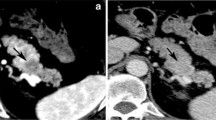Abstract
Objective
The purpose of this pictorial essay is to showcase the use of minimum intensity projection in the imaging of low attenuation structures such as the pancreatic duct.
Conclusion
Minimum intensity projection is a valuable adjunct to other processing techniques for the diagnosis and staging of pancreatic adenocarcinoma and cystic tumors of the pancreas.














Similar content being viewed by others
References
Calhoun PS, Kuszyk BS, Heath DG, et al. (1999) Three-dimensional volume rendering of spiral CT data: theory and method. RadioGraphics 19:745–764
Kim HC, Park SJ, Park SI, et al. (2005) Multislice CT cholangiography using thin-slab minimum intensity projection and multiplanar reformation in the evaluation of patients with suspected biliary obstruction: preliminary experience. J Clin Imaging 29:46–54
Nino-Murcia M, Jeffrey RB Jr, Beaulieu CF, et al. (2001) Multidetector CT of the pancreas and bile duct system: value of curved planar reformations AJR 176:689–693
Johnson PT, Heath DG, Hofmann LV, et al. (2003) Multidetector-Row computed tomography with three-dimensional volume rendering of pancreatic cancer: a complete preoperative staging tool using computed tomography angiography and volume-rendered cholangiopancreatography. J Comp Asst Tomogr 27:347–353
Park SJ, Han JK, Kim TK, et al. (2001) Three-dimensional spiral CT cholangiography with minimum intensity projection in patients with suspected obstructive biliary disease: comparison with percutaneous transhepatic cholangiography. Abdom Imaging 26:281–286
Cody DD (2002) AAPM/RSNA Physics tutorial for residents: topics in CT: image processing in CT. RadioGraphics 22:1255–1268
Raptopoulos V, Prassopoulos P, Chuttani R, et al. (1998) Multiplanar CT pancreatography and distal cholangiography with minimum intensity projections. Radiology 207:317–324
Novick SL, Fishman EK (1998) Three-dimensional CT angiography of pancreatic carcinoma: role in staging extent of disease. AJR 170:139–143
Nino-Murcia M, Tamm EP, Charnsangavej C, et al. (2003) Multidetector-row helical and advanced postprocessing techniques for the evaluation of pancreatic neoplasms. Abdom Imaging 28:366–377
Acknowledgments
We would like to thank Laura Pierce, MPA, RT, (CT), our 3D laboratory manager, for her help in acquiring images and providing support for this project.
Author information
Authors and Affiliations
Corresponding author
Rights and permissions
About this article
Cite this article
Salles, A., Nino-Murcia, M. & Jeffrey, R.B. CT of pancreas: minimum intensity projections. Abdom Imaging 33, 207–213 (2008). https://doi.org/10.1007/s00261-007-9212-6
Published:
Issue Date:
DOI: https://doi.org/10.1007/s00261-007-9212-6




